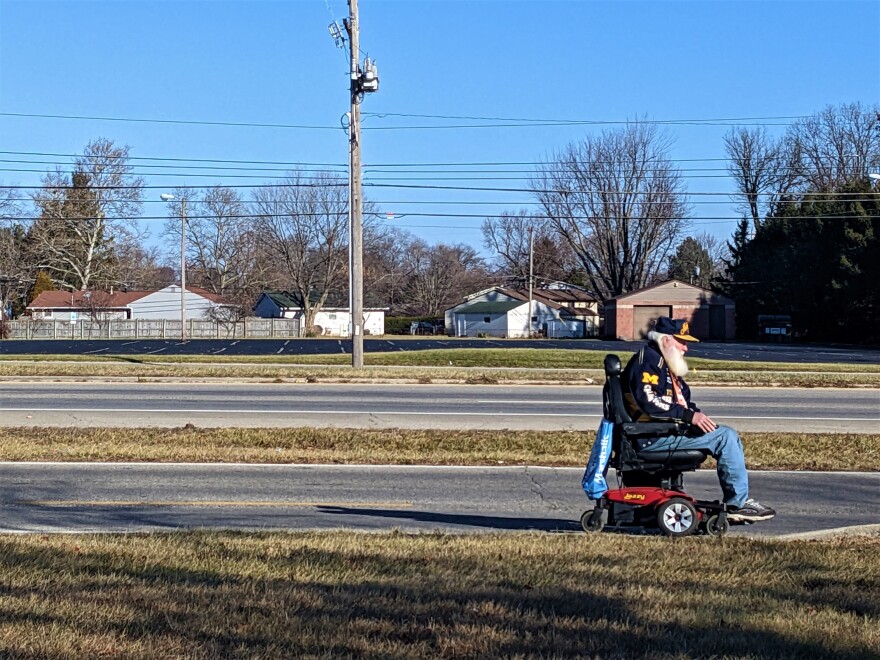For decades, urban and suburban planners focused on cars rather than pedestrians when building infrastructure. Now Columbus and other cities are playing catch-up in adding safe sidewalks and shared-use paths.
WOSU's Curious Cbus received a submission asking why only about half of Columbus streets had sidewalks and "How much does the City of Columbus invest in building new sidewalks each year?"
One example of the issue can be seen on a stretch of Dublin Granville Road between Interstate 71 and Cleveland Avenue. There are pharmacies, restaurants, apartment complexes and shopping centers along the road, but no sidewalks.
That’s because when this area was built up from a country road to the developed corridor we see today, the U.S. was steeped in car culture. Pedestrians were simply not a concern for the city or developers. But Columbus is working to correct that oversight and plans to construct a sidewalk there next year.
Justin Goodwin is a transportation planning manager with the City of Columbus. He said the lack of sidewalks comes from the country’s general shift from urban centers to less dense suburban development.
"Walking became a little bit out of fashion in the planning and design of our neighborhoods and our job centers, both here in Columbus, throughout the region, and really nationally," Goodwin said. "That was a trend that I think we now recognize had a number of unintended consequences."
Those consequences include streets that aren’t safe for pedestrians and cyclists. It also meant a lack of investment in the needs of senior citizens, those with disabilities and people who don't have cars.

"Today in Franklin County, nearly 40,000 households don't have access to their own personal vehicle in the household, and many others don't have access to a consistently reliable one," said Goodwin.
To address some of these inequities, the city has been working to improve walkability with updated policies, adopting a design approach known as Complete Streets. Basically, that means all new projects require sidewalks or paths and that pedestrian infrastructure should be added to older streets when possible.
But building sidewalks is not cheap. It can take up to $2 million to construct a mile of sidewalk, depending on the specifics of the project and material costs.
Each year, the capitol budget includes $6 million directly for sidewalks and shared-use paths. Other city sources such as the Department of Development’s Urban Infrastructure Recovery Fund can fund sidewalks as well.
Federal transportation dollars also go to local projects through the Mid-Ohio Regional Planning Commission, or MORPC.
Tom Graham, a senior planner with MORPC, said the process of approving sidewalk projects is largely data-driven.
"We are trying to find which projects will get used the most, which ones are filling the most important gaps," Graham said. "Really, [we're] just trying to make sure that the projects that we're funding are going to be impactful for getting bikes and pedestrians across areas where they currently either can't or are generally unsafe in their current travels."
In the next decade, MORPC will allocate tens of millions of dollars to sidewalk and shared-use path projects in the region. In some cases, MORPC can fund up to 80% of a construction project.

This type of investment is top of mind for city planners and engineers who know that walkability and access to public transportation are important to growing metro areas.
"It's pretty clear that to attract people to your community, you need to have a holistic transportation system, not one that is exclusively for cars," Graham said.
In Columbus, the city is picking projects that prioritize pedestrian safety. Data shows an increase in traffic-related pedestrian deaths in recent years, with 24 deaths in 2021.
According to Goodwin, his department makes decisions using the city's High Injury Network, which maps the areas where accidents and injuries are most likely to occur.
"More and more, our emphasis is on building that infrastructure on our arterial roadway system, the higher volume, higher traffic, higher speed roadways, the ones that fall on that High Injury Network," he said.
Progress will be slow but since 2017, the city and private developers constructed over 20 miles of new sidewalks.
The city says that about 64% of its streets have a sidewalk or path today.

Where the sidewalk ends
Many have also written to Curious Cbus to ask questions about why sidewalks seem to pop up and end randomly on some streets. Others want to know why some curbs have ramps on the corner, but no actual sidewalks.
The basic answer is that building codes have changed over time. It was not always required for new developments to build sidewalks.
Justin Goodwin said that one can often get a sense of when a home was built by looking at whether or not it has a sidewalk in front of it.
"There are streets where some homes have sidewalks in front of them and the home next door, or the next block down, doesn't because of the time period in which the home was built," Goodwin said.
The hope is that over time all these seemingly arbitrary sections will connect to create a complete system.
"Pedestrian infrastructure development happens often in a piecemeal fashion without a coordinated plan or regulations requiring that infrastructure to be built," he said. "It is a constant work in progress to go back and retrofit many of those streets."



